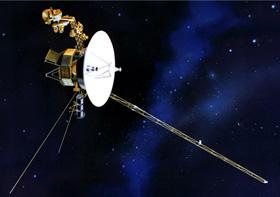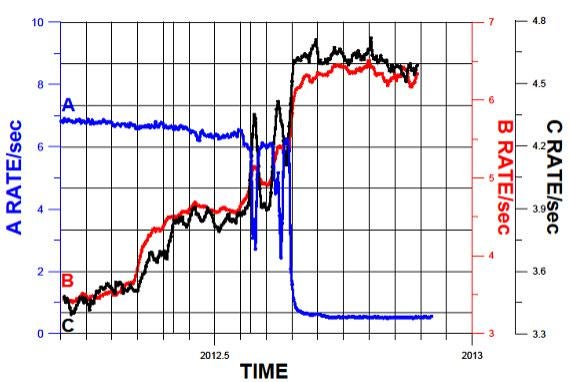[Correction, March 20, 2013: I wrote the piece below after reading a press release from the American Geophysical Union (AGU) and after reading the professional science journal paper announcing the results. Just after posting this I received a press release from NASA/JPL quoting Ed Stone, the Voyager project scienist, saying “It is the consensus of the Voyager science team that Voyager 1 has not yet left the solar system or reached interstellar space. In December 2012, the Voyager science team reported that Voyager 1 is within a new region called ‘the magnetic highway’ where energetic particles changed dramatically. A change in the direction of the magnetic field is the last critical indicator of reaching interstellar space and that change of direction has not yet been observed.”
[Emphasis mine.] I then received a follow-up press release from the AGU also backing off the claim of Voyager leaving the solar system.
This is what I was alluding to in the third-to-last paragraph in the post below, why I emphasized the announcement from December, and why I was using the word “apparently” a lot. I did base this on what I read in the original press release and paper, but given the new JPL release I take responsibility for any statements I wrote making this seem firmer than warranted.
I’ll note there is some argument over what constitutes the boundary of the solar system. The transition region I describe below is one such boundary, but as Dr. Stone says the region where the magnetic field direction changes is a better, final one. I’m satisfied with this. Interestingly, the JPL press release doesn’t define what the boundary of the heliosphere itself is, which strikes me as smart. These are not really definitions so much as concepts, since a hard edge is usually difficult to come by in astronomy.
So to be clear, the science of what I describe below is accurate enough, but the idea that Voyager 1 has left the building is not. The original text of the post is below. UniverseToday.com has a good article on this as well.]
It looks like humanity may have become the Earth’s first interstellar species.
The spacecraft Voyager 1, launched on Sep. 5, 1977, has apparently left the solar system.
A new paper has just been released showing that Voyager 1 has definitely breached the edge entered into a new part of the Sun’s heliosphere, the huge region around the solar system dominated by the Sun’s solar wind. This is essentially confirmation of what had already been announced in December 2012, so this isn’t exactly new news, but given the paper has been peer-reviewed and accepted for publication, this makes it official.

Image credit: NASA/JPL-Caltech
So what does this mean?
The Sun blows out a wind of subatomic particles at high speed, and these flow out and past the inner planets, into interstellar space. At a distance of roughly 18 billion kilometers, about four times the distance of Neptune from the Sun, that wind is slowed to a stop by slamming into the particles that exist between the stars, what we call the interstellar medium.
That point where the solar wind stops is as good a definition of the edge of our solar system as any other. And Voyager 1 is now on the other side of it.
Back in December 2012 it was announced that there were very strong signs that Voyager was passing through the doorway to interstellar space. Just at the poetically-named heliopause—where the solar wind stops—the characteristics of the environment change. We give the generic name of “cosmic rays” to particles zipping around space, and the ones from the Sun have a very different energy, in general, than the ones past the heliopause that come from the greater galaxy around us.

Image credit: Webber and McDonald
The new paper shows that on Aug. 25, 2012, Voyager 1 reached the point in space where it detected that change, just as was previously announced. In a matter of days, the number of solar cosmic rays dropped precipitously, and the galactic cosmic rays ramped up at the same time.
This means that for real and for sure, Voyager 1 has left the heliosphere.
So where is it now? Well, we have to be careful. This is literally unexplored territory. Most models of how the heliosphere works have a fuzzy boundary between inside and outside (though Voyager 1 is definitely outside). There could be another region outside of that, for example, though no one is sure. More data from Voyager 1 may be able to clear that up over time.
But either way, it has slipped the surly bounds of the Sun’s influence and is still moving with enough velocity to carry it out into the galaxy. Our proxy, our envoy, is heading out to the stars, where it belongs.
It’s just the first. There will be many more, some of which are already well on their way. Someday, perhaps, we may join them.
